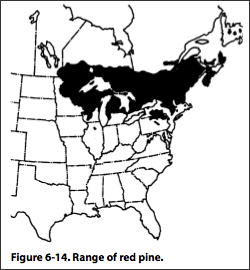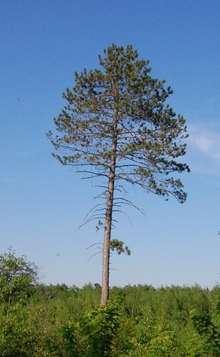Quick facts
- Red pine is common on sandy soils, but it grows best on well-drained sandy to loamy soils.
- Clear-cutting followed by planting is the most reliable way to regenerate red pine.
- For wood production, the recommended rotation age for red pine is 60 to 90 years.
- On most sites, you will want to control shrubs and expose mineral soil.
- A common spacing for red pine is 7 feet by 7 feet.
Red (also known as Norway) pine is commonly used for pulpwood to produce high-grade printing and wrapping papers. It is also used for lumber, veneer, pilings, poles, cabin logs and posts.
Red pine stands are generally considered poor habitat for game birds and animals, but bald eagles and many songbirds use old-growth trees as nesting sites.
Growing conditions
Red pine often grows in relatively pure stands, with trees of about the same age. These are known as even-aged stands.
On drier sites, it grows in pure stands or is mixed with jack pine, aspen, paper birch and oaks.
On moist sites, it is often mixed with eastern white pine, red maple, northern red oak, balsam fir or white spruce.
Red pine is common on sandy soils, but it grows best on well-drained, but not dry, sandy to loamy soils. Heavy, wet soils are poor sites for red pine.
Regenerating red pine
Clear-cutting followed by planting is the most reliable way to regenerate red pine. This is because the tree cannot tolerate shade, and good seed crops only occur at three- to seven-year intervals.
A rotation is the number of years required to establish and grow trees to a desired size, product or maturity.
For wood production, the recommended rotation age for red pine is 60 to 90 years. However, red pine is a long-lived species, providing opportunities to grow stands for 200 years and individual trees to even greater ages.
- Any site preparations made prior to planting should reduce competition for light, water and nutrients while avoiding any serious soil loss.
- On most sites, you will want to control shrubs and expose mineral soil.
- To prepare the site, you can use mechanical equipment, herbicides, prescribed burning or a combination of these.
A common spacing is 7 feet by 7 feet. You can plant trees at wider spacings, up to 10 feet by 10 feet, if you expect high survival. Closer spacing reduces tree taper and branch size, promotes early crown closure and suppresses competition. Closer spacing does require more frequent thinnings to maintain stand vigor and health.
The most common planting stock is 3-0 bare-root seedlings, but 2-0 seedlings are sometimes used. These seedlings are grown for three or two years, respectively, at a nursery without transplanting. To extend the planting season, you can use containerized seedlings.
Intermediate treatments
Thin and remove competing trees and shrubs to keep red pine crop trees free from overhead shade and provide needed growing space.
You may need to completely remove low competition, such as shrubs, near two- and three-year seedlings. Also, release groups of trees overtopped by hardwoods as soon as possible.
Red pine responds favorably to many types of thinnings and intermediate treatments. These treatments are essential to maintain stand health and vigor as individual trees grow and compete with one another.
Guidelines for treating red pine are based on the trees’ average diameter at breast height (DBH) and basal area (the sum of trees’ cross-sectional areas at DBH, measured in square feet per acre). Basal area typically ranges from zero (no large trees present) to more than 200 square feet (large trees present that form a dense forest).
Some guidelines are:
- Seedling stands (less than 2 inches DBH): If there are more than 2,000 trees per acre, give at least 100 potential crop trees at least 25 square feet of growing space each.
- Sapling stands (2 to 5 inches DBH): If stands are dense, thin so each tree has 50 square feet of growing space (7 by 7 foot spacing).
- Pole stands (5 to 9 inches DBH): If stands have more than 140 square feet of basal area per acre, thin them to about 90 square feet of basal area per acre.
- Small sawtimber stands (9 to 15 inches DBH): Grows well at densities around 120 square feet of basal area per acre.
- Large sawtimber stands (15 inches or larger DBH): Can be managed at densities of 150 or even 180 square feet of basal area per acre.
Red pine grows optimally at about 90 to 110 square feet of basal area per acre. As a general rule, remove less than half of the basal area in any one thinning. During early thinnings, cut trees that are smaller, slower growing and lower quality than the stand average.
To produce high-quality sawtimber, prune the lower 17 feet of crop trees when they are pole-timber-sized.
Pest management
Bark beetles are very serious pests, particularly in dense stands on sandy soils during drought years.
To avoid bark beetle damage, follow these guidelines:
- If you thin or cut in the winter or early spring, remove logs and slash before June 1.
- If you thin or cut in the summer, remove logs and slash within three weeks.
- Remove or destroy woody debris greater than three inches in diameter.
- Avoid wounding trees during thinning and harvesting operations.
- Avoid wounding residual trees during thinning.
Defoliating insects include sawflies and jack pine budworm. Where needed, you can control them with insecticides.
The European pine shoot moth and the Zimmerman pine moth damage tips and buds, deforming the main stem. Cultural controls are not effective. There are not any changes you can make to the natural environment to control these moths. And the usefulness of insecticides against them is limited.
The Saratoga spittlebug, white grubs and pine root collar weevils also injure or kill red pine. Here is what you need to do to control these pests:
- Spittlebug: Remove sweetfern.
- White grubs: Kill sod.
- Root collar weevil: Prune lower branches and rake up needles near the tree’s base.
Scleroderris canker, red pine shoot blight, diplodia, root rots, butt rots and needle blights may be important in some areas. The best control measures are to:
- Remove infected trees.
- Maintain stand vigor through favorable growing conditions.
- Avoid establishing young stands beneath or near infected older pine trees.
Deer, hare, rabbit, porcupine or mice may cause injury. To decrease hare, rabbit and mouse activity, eliminate protective grass. You may need animal control or repellents in other cases.
Reviewed in 2018




